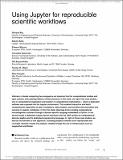Using Jupyter for reproducible scientific workflows
Abstract
Literate computing has emerged as an important tool for computational studies and open science, with growing folklore of best practices. In this work, we report two case studies - one in computational magnetism and another in computational mathematics - where a dedicated software was exposed into the Jupyter environment. This enabled interactive and batch computational exploration of data, simulations, data analysis, and workflow documentation and outcome in Jupyter notebooks. In the first study, Ubermag drives existing computational micromagnetics software through a domain-specific language embedded in Python. In the second study, a dedicated Jupyter kernel interfaces with the GAP system for computational discrete algebra and its dedicated programming language. In light of these case studies, we discuss the benefits of this approach, including progress towards more reproducible and re-usable research results and outputs, notably through the use of infrastructure such as JupyterHub and Binder.
Citation
Beg , M , Belin , J , Kluyver , T , Konovalov , A , Ragan-Kelley , M , Thiery , N & Fangohr , H 2021 , ' Using Jupyter for reproducible scientific workflows ' , Computing in Science and Engineering , vol. 23 , no. 2 , 9325550 , pp. 36-46 . https://doi.org/10.1109/MCSE.2021.3052101
Publication
Computing in Science and Engineering
Status
Peer reviewed
ISSN
1521-9615Type
Journal article
Description
Funding: This work was financially supported by the OpenDreamKit Horizon 2020 European Research Infrastructure project (676541) and the EPSRC Programme grant on Skyrmionics (EP/N032128/1).Collections
Items in the St Andrews Research Repository are protected by copyright, with all rights reserved, unless otherwise indicated.

